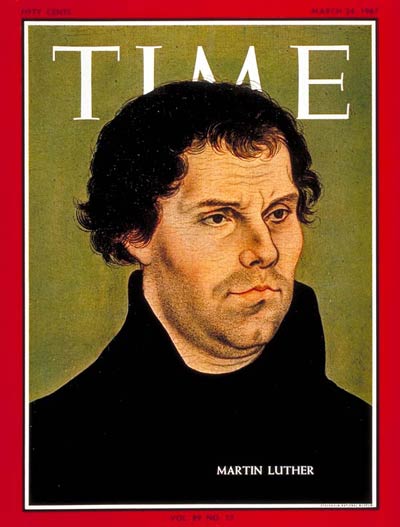
Milestone moments do not a year make. Often, it’s the smaller news stories that add up, gradually, to big history. With that in mind, in 2017 TIME History will revisit the entire year of 1967, week by week, as it was reported in the pages of TIME. Catch up on last week’s installment here.
As the 450th anniversary approached of Martin Luther’s posting of his 95 theses on the door of a church in Wittenberg, Germany, TIME took a look at the entire history of Protestantism — including the question of whether the religion of the 1960s needed a new Luther to intervene.
No matter the circumstances, however, the appearance of such a figure seemed unlikely. Not only was the life of the man who launched the Protestant Reformation unique, the urge to reform the church by launching a new church seemed far from a solution in a modern world — the world Luther helped create — where it was possible to “try to remain a Christian outside organized Christianity,” as one priest put it. Plus, Pope John XXIII seemed as willing to reform the Catholic Church as anyone else might be.
But the urge to seek a Luther was not surprising, the piece explained:
So large is Luther that every age has been able to find in him a religious hero to its own liking. To the Enlightenment he was above all an individualist and rationalist who sneered at superstition and fought totalitarianism. The Romantic era saw Luther as a German nationalist, the rebel against Roman imperialism. Turn-of-the-century Christian liberals pictured him as a primitive reductionist who tried to return the church to its apostolic simplicity. Since Luther’s fears, foibles and physical ailments are amply documented—notably in his own writings, which fill some 100 volumes in the authoritative Weimar Edition—he has provided a wide target for psychoanalysts and playwrights. A successful case in point is John Osborne’s Luther, in which the reformer came across as a manic-depressive lout, whose rebellion against the church was motivated by a father fixation and a bad case of constipation.
Luther defies easy characterization, however, since his life and work add up to a complex of paradoxes. An authentic spiritual revolutionary, he was at the same time a social and political conservative, wedded to the ideals of feudal society. A limpid preacher of God’s majesty and transcendence, he was capable of a four-letter grossness of language. He was the archetype of individual Christian assertion; yet he could be brutally intolerant of dissent, and acquiesced in the suppression of those he considered heretics. Prayerful and beer-loving, sensual and austere, he was the least saintly, but most human, of saints.
Get your history fix in one place: sign up for the weekly TIME History newsletter
Things to come: Richard Nixon had thrown his “well-worn hat” in the ring for the following year’s presidential election, though he was careful to say that he had not made up his mind to run. His supporters, however, were eager to get behind a man “respected everywhere around the world.”
At Arlington: More than three years after his death, John F. Kennedy’s body was finally brought to Arlington National Cemetery, the national news section reported, and buried next to the two babies he and Jackie had lost. Despite the fight between Sen. Robert Kennedy and President Lyndon Johnson that TIME had reported on in the previous week’s issue — the veracity of which the publisher had to defend — the two men were among the small group that came to pay their respects.
Two perspectives: This issue contains an interesting (and very modern) juxtaposition. The TIME Essay — the unbylined analysis-opinion format that appeared in most issues at the time — concluded that “crime in the U.S. is a national disgrace,” the crime rate was spiraling upward and that the nation’s police needed more support in their dangerous work. Meanwhile, in the legal-news section, readers learned about a case in which police in Nashville had shot and killed an unarmed student who seemed to have been suffering a psychiatric emergency, and the debate over whether such use of force was necessary.
Great vintage ad: Maybe I’m reading too much into this, but I’m pretty sure this utility-company ad is a weird “joke” about World War II or Cold War resistance movements in Poland.
Coming up next week: The aerospace industry and James McDonnell.
More Must-Reads From TIME
- The 100 Most Influential People of 2024
- The Revolution of Yulia Navalnaya
- 6 Compliments That Land Every Time
- What's the Deal With the Bitcoin Halving?
- If You're Dating Right Now , You're Brave: Column
- The AI That Could Heal a Divided Internet
- Fallout Is a Brilliant Model for the Future of Video Game Adaptations
- Want Weekly Recs on What to Watch, Read, and More? Sign Up for Worth Your Time
Write to Lily Rothman at lily.rothman@time.com